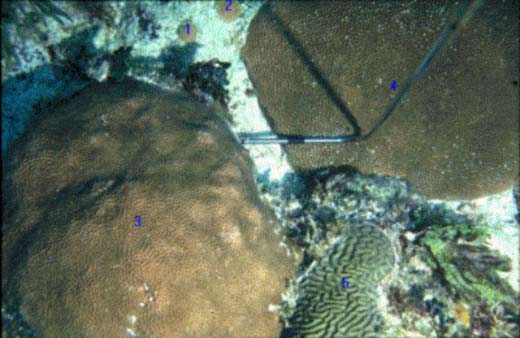|
|
SYSTAT : SIGMAPLOT : TableCurve2D : TableCurve3D : PeakFIT : AutoSignal |
PRODUCT USES |
|---|
CORAL COVERAGE AND DIVERSITY INVESTIGATIONS IN QUINTANA ROO, MEXICO
Preliminary investigations of coral coverage and diversity measurements were conducted in the shallow reef zone of a fringing reef in central Quintana Roo, Mexico (1). Using digitized images from photo transects of the reef, substrate coverage and diversity determinations for hermatypic coral species were conducted using SigmaScan Pro. Results indicated low substrate coverage (9.9%) and diversity measurements (0.94) for all hermatypic species within the shallow reef zone.
Prior to using SigmaScan Pro, each photo transect image was processed as slide film, projected at a size ratio of 1:1 (according to a size standard within each image) and superimposed onto a grid. The image superimposed on each grid-point was then identified and recorded. All diversity and substrate coverage measurements were determined using this method. Using SigmaScan Pro, it is now possible to accurately measure substrate coverage and coral diversity as a function of true substrate coverage (Figure 1).

Figure 1: A photo-transect image showing a total area of 2,319 cm2. Colonies 1-4 represent one species and cover 3.9, 6.2, 832, and 637 cm2 respectively. Colony 5 is a separate species and covers 114 cm2. Total hermatypic coral coverage in this image is 1,594 cm2, or 68%.
This image is an excellent example of how SigmaScan Pro can be used to easily retrieve real spatial data which previously would have required a great deal of time and effort. A size standard is used to calibrate measurements of coral colony area or substrate coverage. The Area measurement feature is used to measure the calibrated areas for each of the coral colonies (#1-5).
A more thorough investigation of coral coverage, diversity, and coral pigmentation as a response to light availability will be conducted on the deeper fore-reef region. These images will be analyzed with SigmaScan Pro for accurate measurements of total coral coverage by species and total coral diversity (indexed to total substrate coverage per species) as was done in Figure 1. However, the next step will be to take advantage of the software's additional color capability and perform analyses on the intra-specific coral pigmentation variability as a response to light availability. This will be accomplished using an RGB color standard to color correct each image to true values during digitization. Coral pigmentation changes in response to light availability will be determined by analyzing the mean values within each RGB color channel for each coral colony and noting if any correlations exist.
Coral coverage and diversity measurements are important indicators of reef health, and the very nature of image digitization lends itself to data archival for comparative studies as a function of time. Coral coverage and diversity measurements have long been held as mainstays of coral reef monitoring projects. An easy and successful means of retrieving comparative coral pigmentation data will aid future research projects in monitoring several threats to reef health which manifest themselves in coral color changes (e.g. coral bleaching, "black band" disease, etc.). We plan to use SigmaScan Pro to develop this methodology.
1. Scott P. Milroy, Texas A&M University - Corpus Christi